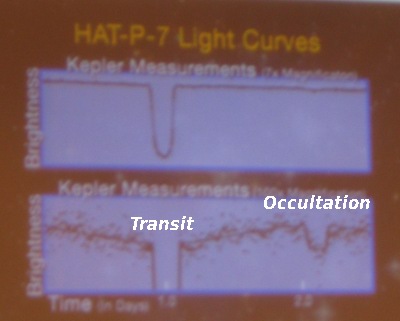Result from Kepler : a planet’s light blocked by a star
This morning the invited talk at the AAS meeting was William Bourucki of NASA/Ames talking about first results from the Kepler mission. The coolest thing he described was an object that’s too hot to be a planet, but too big to be the kind of star it could be…! More about that later.
Right now, I want to show my blurry snapshot of his plot of the lightcurve of an already-known exoplanet named HAT-P-7:

This is a plot of the brightness of the star versus time. This was a previously known planet. In the top, you see the Kepler data that results from when the planet transits the star. That is, the planet moves across the face of the star, blocking out a little bit of the starlight, causing the star to get just a wee bit dimmer. The planet is much dimmer than the star, so it only blocks out a bit of the starlight, but Kepler is sensitive enough that this is an extremely strong detection.
What’s cool is when you zoom in on the plot. You see a second dip to the right. What you’re seeing there is the light of the planet being blocked by the star. The planet shows reflected light from the star, which adds to the overall light you see. However, when the planet is occulted by the star, you no longer see that reflected light… and you get a secondary dip.
A number of extrasolar planets have been detected by looking for stars whose light is briefly blocked out due to an orbiting planet moving in front of the star. Kepler is a spacecraft designed to find lots of these planets. It’s really cool that it’s sensitive enough that it’s seeing the light of a planet blocked out by a star…!
